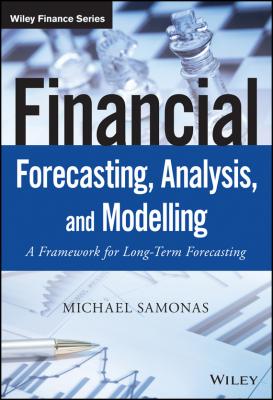ТОП просматриваемых книг сайта:
Financial Forecasting, Analysis and Modelling. Michael Samonas
Читать онлайн.Название Financial Forecasting, Analysis and Modelling
Год выпуска 0
isbn 9781118921098
Автор произведения Michael Samonas
Жанр Зарубежная образовательная литература
Издательство John Wiley & Sons Limited
Readers of this book should bear in mind that, although Excel is an incredible tool and without it we would not have had the incredible financialization of the world economy over the past 30 years, errors can easily happen while trying to model real life situations. Proper controls put in place can minimize possible errors and prevent wrong decisions.
BIBLIOGRAPHY AND REFERENCES
1. Investopedia, http://www.investopedia.com/terms/f/financialmodeling.asp.
2. Moneyterms, http://moneyterms.co.uk/financial-model/.
3. Wikipedia, http://en.wikipedia.org/wiki/Financial_modeling.
4. Institute of Chartered Accountants in England and Wales (ICAEW) “Twenty principles for good spreadsheet practice”, June 2014, http://www.icaew.com/home/technical/information-technology/excel/twenty-principles.
5. The FAST Standard, http://www.fast-standard.org/.
6. The SMART Standard, Corality, http://www.corality.com/financial-modelling/smart.
7. Best Practice Spreadsheet Modeling Standards http://www.bestpracticemodelling.com.
8. Spreadsheet Standards Review Board-SSRB, http://www.ssrb.org/.
9. Juan Arangote, “Subjective Viewpoint. Financial Modeling: The math and art of painting the future today” (July/August 2014) 34(6) AFP Exchange 40–42, http://www.afponline.org/exchange/.
10. The European Spreadsheet Risks Interest Group – EuSpRIG, http://www.eusprig.org/index.htm.
11. WIKIBOOKS, http://en.wikibooks.org/wiki/Financial_Modelling_in_Microsoft_Excel/Testing.
12. Weiser Mazars, 2011, Insurance Finance Leadership Study, http://www.weisermazars.com/images/2011_Insurance_Finance_Leadership_Study.pdf.
13. 2014 gtnews FP&A Technology Survey, http://gtnews.afponline.org/Research/2014_gtnews_FP_A_Technology_Survey.html.
14. Tim Worstall, “Microsoft's Excel Might Be The Most Dangerous Software on the Planet”, Forbes, 13 February 2013, http://www.forbes.com/sites/timworstall/2013/02/13/microsofts-excel-might-be-the-most-dangerous-software-on-the-planet/.
15. “Imagine there is no Excel”, CFO.COM, 18 January 2012, http://ww2.cfo.com/analytics/2012/01/imagine-there-is-no-excel/.
16. “Beware of the Spreadsheet”, Accounting and Business International, May 2014, http://issuu.com/accaglobal_publications/docs/ab_int_may14_comp_rgb.
Chapter 2
A Short Primer in the Accounting of Financial Statements
Chapter 2 explains the basics of the financial statements and the Generally Accepted Accounting Principles (GAAP) that underlie their construction. Financial statements are the primary source of information for most investors and analysts. While an understanding of every detail and International Accounting Standards Board (IASB)1 rule is not necessary, it is important that the reader understands at least the basics. The accounting equation is used to prepare the balance sheet, the income statement, and the statement of cash flows and the interrelationships among these statements are explained. A sample company's financial statements highlight the abovementioned articulation by using a proper graphical exhibit. Finally the most important financial ratios are described as a means of financial statement analysis and interpretation.
2.1 THE ACCOUNTING EQUATION
Any aspiring financial modeller should be familiar with the basic accounting principles and how they are reflected in the so-called financial statements. Financial statements are standardized forms developed by accountants and financial managers in order to record business transactions. They follow the fundamental principle of accounting: matching costs and expenses with the revenues they have created. In order for costs and expenses to be matched with revenues, accountants devised what is known as the double entry system of accounting. In other words, every transaction is listed in 2 places. Double entry accounting is largely attributed to the Italian mathematician and Franciscan monk known as Luca Pacioli who lived from 1445 to 1517. Pacioli is credited with the first publication of the “Venetian method” of keeping accounts, a system for maintaining financial records.
Конец ознакомительного фрагмента.
Текст предоставлен ООО «ЛитРес».
Прочитайте эту книгу целиком, купив полную легальную версию на ЛитРес.
Безопасно оплатить книгу можно банковской картой Visa, MasterCard, Maestro, со счета мобильного телефона, с платежного терминала, в салоне МТС или Связной, через PayPal, WebMoney, Яндекс.Деньги, QIWI Кошелек, бонусными картами или другим удобным Вам способом.

